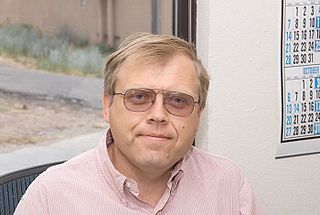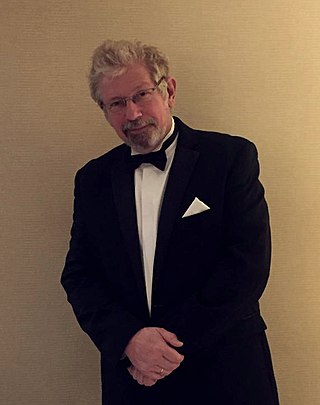
A Majorana fermion, also referred to as a Majorana particle, is a fermion that is its own antiparticle. They were hypothesised by Ettore Majorana in 1937. The term is sometimes used in opposition to a Dirac fermion, which describes fermions that are not their own antiparticles.

Balázs László Győrffy was a Hungarian-American-British theoretical physicist. In his obituary, the Times Higher Education described him as "one of the dominant international figures in the development of the theory of condensed matter". Győrffy is thought to be the first person to use the term "electron glue" to describe the sea of electrons binding together the nuclei in materials.

The 122 iron arsenide unconventional superconductors are part of a new class of iron-based superconductors. They form in the tetragonal I4/mmm, ThCr2Si2 type, crystal structure. The shorthand name "122" comes from their stoichiometry; the 122s have the chemical formula AEFe2Pn2, where AE stands for alkaline earth metal (Ca, Ba Sr or Eu) and Pn is pnictide (As, P, etc.). These materials become superconducting under pressure and also upon doping. The maximum superconducting transition temperature found to date is 38 K in the Ba0.6K0.4Fe2As2. The microscopic description of superconductivity in the 122s is yet unclear.

Piers Coleman is a British-born theoretical physicist, working in the field of theoretical condensed matter physics. Coleman is professor of physics at Rutgers University in New Jersey and at Royal Holloway, University of London.

Alexander V. Balatsky is a USSR-born American physicist. He is the professor of theoretical physics at NORDITA and University of Connecticut. He served as the founding director of the Institute for Materials Science (IMS) at Los Alamos National Laboratory in 2014–2017.

Alexandre Bouzdine (Buzdin) (in Russian - Александр Иванович Буздин; born March 16, 1954) is a French and Russian theoretical physicist in the field of superconductivity and condensed matter physics. He was awarded the Holweck Medal in physics in 2013 and obtained the Gay-Lussac Humboldt Prize in 2019 for his theoretical contributions in the field of coexistence between superconductivity and magnetism.
Elihu Abrahams was a theoretical physicist, specializing in condensed matter physics.
Gerald Dennis Mahan was an American condensed matter physicist, with specific research interests in transport and optical properties of materials, and solid-state devices. He was a fellow of the American Physical Society.
Bulbul Chakraborty is the Enid and Nate Ancell Professor of Physics at Brandeis University. She is recognized for her contributions to soft condensed matter theory studying systems far from equilibrium, such as granular materials, amorphous systems, and statistical physics. She is an elected American Physical Society and American Association for the Advancement of Science fellow.

Antonio Helio de Castro Neto is a Brazilian-born physicist. He is the founder and director of the Centre for Advanced 2D Materials at the National University of Singapore. He is a condensed matter theorist known for his work in the theory of metals, magnets, superconductors, graphene and two-dimensional materials. He is a distinguished professor in the Departments of Materials Science Engineering, and Physics and a professor at the Department of Electrical and Computer Engineering. He was elected as a fellow of the American Physical Society in 2003. In 2011 he was elected as a fellow of the American Association for the Advancement of Science.
Richard L. Greene is an American physicist. He is a distinguished university professor of Physics at the University of Maryland. He is known for his experimental research related to novel superconducting and magnetic materials.
William P. Halperin is a Canadian-American physicist, academic, and researcher. He is the Orrington Lunt Professor of Physics at Northwestern University.

Alexander Avraamovitch Golubov is a doctor of physical and mathematical sciences, associate professor at the University of Twente (Netherlands). He specializes in condensed matter physics with the focus on theory of electronic transport in superconducting devices. He made key contributions to theory of Josephson effect in novel superconducting materials and hybrid structures, and to theory of multiband superconductivity.
Christopher John Pethick is a British theoretical physicist, specializing in many-body theory, ultra-cold atomic gases, and the physics of neutron stars and stellar collapse.
Peter David Nellist, is a British physicist and materials scientist, currently a professor in the Department of Materials at the University of Oxford. He is noted for pioneering new techniques in high-resolution electron microscopy.
Maria Roser Valentí is a Spanish-Catalonian professor of theoretical condensed matter physics at Johann Wolfgang Goethe-Universität Frankfurt am Main.
Dale J. Van Harlingen is an American condensed matter physicist.
Robert Everett Ecke is an American experimental physicist who is a laboratory fellow and director emeritus of the Center for Nonlinear Studies (CNLS) at Los Alamos National Laboratory and Affiliate Professor of Physics at the University of Washington. His research has included chaotic nonlinear dynamics, pattern formation, rotating Rayleigh-Bénard convection, two-dimensional turbulence, granular materials, and stratified flows. He is a Fellow of the American Physical Society (APS) and of the American Association for the Advancement of Science (AAAS), was chair of the APS Topical Group on Statistical and Nonlinear Physics, served in numerous roles in the APS Division of Fluid Dynamics, and was the Secretary of the Physics Section of the AAAS.
Pengcheng Dai is a Chinese American experimental physicist and academic. He is the Sam and Helen Worden Professor of Physics in the Department of Physics and Astronomy at Rice University.
Elbio Rubén Dagotto is an Argentinian-American theoretical physicist and academic. He is a distinguished professor in the department of physics and astronomy at the University of Tennessee, Knoxville, and Distinguished Scientist in the Materials Science and Technology Division at the Oak Ridge National Laboratory.







